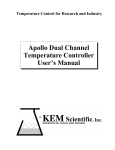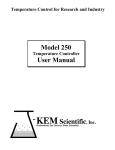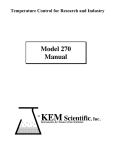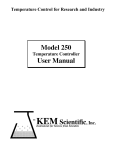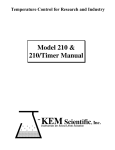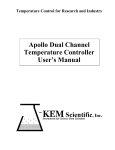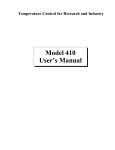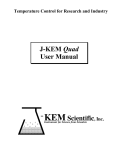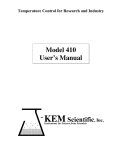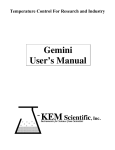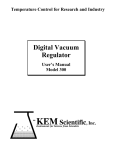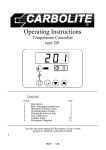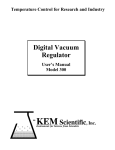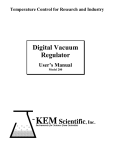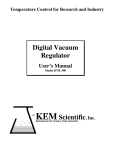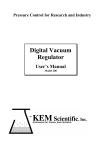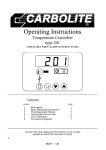Download Model 150 & 150/Timer Manual - J
Transcript
Temperature Control for Research and Industry Model 150 & 150/Timer Manual Warranty J-KEM Scientific, Inc. warrants this unit to be free of defects in materials and workmanship and to give satisfactory service for a period of 12 months from date of purchase. If the unit should malfunction, it must be returned to the factory for evaluation. If the unit is found to be defective upon examination by J-KEM, it will be repaired or replaced at no charge. However, this WARRANTY is VOID if the unit shows evidence of having been tampered with or shows evidence of being damaged as a result of excessive current, heat, moisture, vibration, corrosive materials, or misuse. This WARRANTY is VOID if devices other than those specified in Section 3.2 are powered by the controller. Components which wear or are damaged by misuse are not warranted. This includes contact points, fuses and solid state relays. THERE ARE NO WARRANTIES EXCEPT AS STATED HEREIN. THERE ARE NO OTHER WARRANTIES, EXPRESSED OR IMPLIED, INCLUDING BUT NOT LIMITED TO THE IMPLIED WARRANTIES OF MERCHANTABILITY AND OF FITNESS FOR A PARTICULAR PURPOSE. IN NO EVENT SHALL J-KEM SCIENTIFIC, INC. BE LIABLE FOR CONSEQUENTIAL, INCIDENTAL OR SPECIAL DAMAGES. THE BUYER'S SOLE REMEDY FOR ANY BREACH OF THIS AGREEMENT BY J-KEM SCIENTIFIC, INC. OR ANY BREACH OF ANY WARRANTY BY J-KEM SCIENTIFIC, INC. SHALL NOT EXCEED THE PURCHASE PRICE PAID BY THE PURCHASER TO J-KEM SCIENTIFIC, INC. FOR THE UNIT OR UNITS OF EQUIPMENT DIRECTLY AFFECTED BY SUCH BREACH. Service J-KEM Scientific maintains its own service facility and technical staff to service all parts of the controller, usually in 24 hours. For service, contact: J-KEM Scientific, Inc. 6970 Olive Boulevard St. Louis, MO 63130 (314) 863-5536 Fax (314) 863-6070 Web site & On-Line Catalog: www.jkem.com E-Mail: [email protected] This manual contains parameters specific to temperature controller Serial #_________________. When calling with a technical question, please have the controller’s serial number available. You’ve purchased the most versatile controller available to the research community. We’re confident it can regulate ANY heating/cooling situation you’ll ever encounter. If the information in this manual isn’t adequate to make your application work, call our Engineering Department for assistance. 2 INDEX SECTION PAGE 1. QUICK OPERATING INSTRUCTIONS . . . . . . . . . . . . . . . . . . . . . . . . . . . . 4 2. ADJUSTING THE CONTROLLER FOR STABLE CONTROL WITH VARIOUS HEATERS . . . . . . . . . . . . . . . . . . . . . . . . . . . 2.1 How to Tune the Controller . . . . . . . . . . . . . . . . . . . . . . . . . . . . . . . . . . . 2.2 Auto-Tuning Procedure . . . . . . . . . . . . . . . . . . . . . . . . . . . . . . . . . . . . . . 2.3 Tuning for Heating Mantles: A Special Case . . . . . . . . . . . . . . . . . . . . . 2.4 Sensor Placement . . . . . . . . . . . . . . . . . . . . . . . . . . . . . . . . . . . . . . . . . . . 5 5 6 8 8 3. OPERATIONS GUIDE . . . . . . . . . . . . . . . . . . . . . . . . . . . . . . . . . . . . . . . . . . . 9 3.1 Front Panel Description . . . . . . . . . . . . . . . . . . . . . . . . . . . . . . . . . . . . . . 9 3.2 3.3 3.4 3.5 3.6 3.7 Heater Restrictions . . . . . . . . . . . . . . . . . . . . . . . . . . . . . . . . . . . . . . . . . . Over Temperature Protection Circuit . . . . . . . . . . . . . . . . . . . . . . . . . . . . Timer Controls . . . . . . . . . . . . . . . . . . . . . . . . . . . . . . . . . . . . . . . . . . . . . Temperature Sensor Input . . . . . . . . . . . . . . . . . . . . . . . . . . . . . . . . . . . . Do's and Don'ts When Using Your Controller . . . . . . . . . . . . . . . . . . . . . Resetting the Controller for Use With Heating Mantles. Restoring Factory Defaults. . . . . . . . . . . . . . . . . . . . . . . . . . . . . . . . . . . . 3.8 Changing between PID and ON/OFF Operating Modes . . . . . .. . . . . . . . 3.9 Using the Temperature Ramp Feature . . . . . .. . . . . . . . . . . . . . . . . . . . . . 3.10 Troubleshooting . . . . . . . . . . . . . . . . . . . . . . . . . . . . . . . . . . . . . . . . . . . . 10 11 12 12 13 13 14 15 17 TABLE 1. . . . . . . . . . . . . . . . . . . . . . . . . . . . . . . . . . . . . . . . . . . . . . . . . . . . . . . . . . 17 APPENDIX . . . . . . . . . . . . . . . . . . . . . . . . . . . . . . . . . . . . . . . . . . . . . . . . . . . . . . . . I. Using the Controller With an Oil Bath (Application Note 1) . . . . . . . . . II. Safety Considerations and Accurate Temperature Control. . . . . . . . . . . . IIII. How to Set Up a Reaction Using J-KEM’s Digital Controller. . . . . . . . . . VI. Resetting the Controller to Original Factory Settings . . . . . . . . . . . . . . . 18 18 19 20 24 WARNING: Adhere to the restrictions of SECTION 3.2. Failure to do so may create a significant safety hazard and will void the warranty. 3 Section 1: Quick Operating Instructions The four steps below are the basics of using your temperature controller. The User’s Manual is a reference that explains the controller more fully as well as some of its more sophisticated features. It’s recommended that new users unfamiliar with process controllers read the entire manual carefully. The controller is preprogrammed for use with heating mantles fitted to round bottomed flasks running “typical” organic reactions (i.e., non-polymeric reactions in solvents such as THF, toluene, DMF, etc.). If the controller is used with this type of reaction, the 4 steps below will help you get started. For a primer on how to set up a reaction with your temperature controller: See Appendix III. To use heaters other than heating mantles: See Section 2. Do not use the controller to heat oil baths: See Section 3.2 & Appendix I. For polymer synthesis, atypical, expensive, or safety critical reactions: See Appendix II. 1 Use with appropriately sized equipment. The Model 150 can be used with most common laboratory heaters including heating mantles larger than 100 ml in size, but is not suited for small-scale reactions (see Section 3.2). For small-scale equipment, J-KEM’s 200 Series o controller, which are capable of heating any application or any volume (1ml - 100L) to ± 0.1 C are recommended. 2 Place the thermocouple in the solution being heated. Place at least the first 1/4” of the thermocouple directly in the solution being heated. Thermocouples can be bent without harming them. If you’re heating a corrosive liquid, use Teflon coated thermocouples. 3 Enter the setpoint (i.e., the desired temperature). Hold in the * button and simultaneously press the key to increase or the key to decrease the setpoint. The setpoint can be seen at anytime by holding in the * button, the setpoint appears as a blinking number in the display. 4 Set the timer. For units with digital timers, the timer turns the heating outlet OFF or ON depending on the position of the timer switch and whether any time is present in the display 4 8 0. 0 * Section 2: Adjusting The Controller For Stable Control With Various Heaters 2.1 What is Tuning. The controller's most powerful feature is its ability to regulate virtually any heater with stable temperature control. But what's required for stable control is that the controller be tuned to the heater being used. Tuning is the process that matches the control characteristics of the controller to the heating characteristics of the heater. The controller is said to be tuned to the heater when its memory is programmed with values telling it how fast the heater warms up, cools off, and how efficiently it transfers heat. For example, consider the difference between a heat lamp and a hot plate. When electricity is applied to a heat lamp it begins to heat instantaneously, and when it's turned off it stops heating instantaneously. In contrast, a hot plate may take several minutes to begin heating when electricity is applied and even longer to start cooling when electricity is turned off. Your controller can regulate both a o heat lamp and a hot plate to 1 C. But, to do this it must be programmed with the time constants describing how fast the heater heats when electricity is turned on and how fast it begins to cool when it's turned off. These time constants are called the tuning parameters. Every type of heater has its own unique set of tuning parameters. For the controller to heat with stability, it must have programmed with the tuning parameters for the heater currently being used. Prior to shipment, tuning parameters were programmed into the controller that maximize heating performance for laboratory heating mantles since these are the most common heaters used in research. Tuning is regulated by 5 of the temperature meter’s user programmable functions. The correct value for these 5 functions can be calculated and loaded by the user manually, or the controller can do it automatically with its autotune feature. When Should the Controller be Tuned? If the controller is tuned to one type of heater, heating mantles for example, heating mantle (>= 100 ml) can be used without the need to retune. When changing from mantles to a different type of heater, an oven for example, the controller should be tuned with values describing the oven’s heating characteristics. The effect of tuning is seen below. When the controller is tuned for heating mantles, using it with a heating mantle yields stable temperature control (Plot 1), but poor control results when the same tuning parameters are used with an oven (Plot 2, Curve 1). However, after tuning the controller to the oven, stable temperature control results (Plot 2, Curve 2). Plot 1 Plot 2 80 80 70 70 60 Temp. oC 50 60 Temp. oC 50 Conditions: 400 ml Toluene 500 ml Round bottomed flask 500 ml Heating mantle 40 Curve 1: Controller loaded with tuning parameters for heating mantles 40 30 20 Curve 2: Controller loaded with tuning parameters for drying oven 30 0 10 20 30 40 Time (min) 50 60 5 20 0 10 20 30 40 Time (min) 50 60 It’s important to understand that this controller isn’t a simple ON/OFF type controller (i.e. ON when below the set point, OFF when above [though it can be made to work this way, see Section 3.8]). Rather it’s a predictive controller. Based on the shape (slope) of the heating curve, the controller predicts (calculates) the percent of power to apply to the heater now to control the shape of the heating curve minutes in advance. The importance of the tuning parameters is that they are constants in the equation the temperature meter uses to perform its predictive calculations. If the temperature meter is programmed with tuning parameters that incorrectly describe the heater being used, poor temperature control will o result. But, when the correct values are loaded, temperature regulation of ± 1 is typically achieved. Manual Tuning. Manual tuning is when the values of the 5 tuning parameters are determined manually then entered into the temperature meter via the push buttons on the front of the controller. Experienced users might prefer to manually tune the controller since this allows customization of the heating process. Autotune. Autotune is a feature built into the temperature meter that automatically calculates the tuning parameters (i.e. delay times, heating efficiency, etc.) for any type of heater. After the autotune procedure is complete and the tuning parameters are determined, the controller loads them into its memory for current and future use. Heating mantles are a special case and are covered in a separate paragraph (Section 2.3). 2.2 Autotuning Procedure. This procedure is not recommended for heating mantles (see Section 2.3). In most cases if the over temperature protection circuit is active, it must be inactivated before starting this procedure (see Section 3.3). 1. Set the equipment up in the exact configuration it will be used. For example, to tune to a vacuum oven, place the thermocouple in the room temperature oven and plug the oven into the controller. If the oven (or heater) has its own thermostat or power control, turn both as high as they’ll go. 2. Turn the controller and heater on. For Model 150/Timer units, make sure the timer switch is set so that heating is on (i.e., LED 11 is lit; see Section 3.4). Enter the desired set point temperature. If the o set point isn’t at least 30 C above ambient, skip this procedure and go to the next procedure, “Autotuning the Controller for Very Fine Control” 3. Press and hold in both the and buttons (for 3 seconds) on the front of the temperature meter until the word “tunE” appears in the display then release both buttons. 4. Press the button (5 times) until “CyC.t” appears in the display (if you go past this setting, press the button until you get back to it). 5. First, hold in the ‘*’ button, while holding in the ‘*’ button press the button. Continue to hold both buttons in until the display reads “A --”, or “A ##” where “##” is some number. 6. Release the ‘*’ button and press the button until “tunE” once again appears in the display. 7. Press and hold the ‘*’ button and “tunE” will change to “off” to indicate that autotune is currently off. 8. While holding in the ‘*’ button, press the button to change the display to “on”, then release both buttons. 9. Press and hold both the and buttons (for 3 seconds) until the temperature appears in the display. The controller is now in its autotune mode. While in autotune the display alternates between “tunE” (for autotune) and the process temperature. When the autotune sequence is done (this may take in excess of an hour) the controller stops displaying “tunE” and only displays the process temperature. [To abort autotune manually, repeat steps 3, 8 and 9 except in step 8, press the button until “off” is displayed]. 6 New tuning values loaded into memory Temp Set Point 75% of set point Start AT Heat to set point after entering new parameters OS1 OS2 US During T1 - 4 the controller measures heating delays and rates of heating and cooling T1 T2 T3 T4 Quarter cycle times The autotune sequence. During autotune the controller heats to 75% of the set point temperature, where it oscillates for several cycles before loading the new tuning parameters. After the tuning parameters are loaded it heats to the set point temperature. Tuning below the set point prevents any damage that might occur from overheating. Time Autotuning the Controller for Very Fine Control. This procedure is not recommended for heating mantles (see Section 2.3). In the majority of cases, the procedure above results in stable temperature control with any heater. A second version of the autotune routine is available and can be used when the heater is already at or close to the set point, is being tuned at a temperature close to room temperature, or for very fine control in demanding situations. If stable temperature control doesn’t result after performing the first autotune routine, the procedure below should be performed. Before performing the ‘fine tune’ autotune procedure, the ‘regular’ autotune procedure that precedes this should normally be performed. In most cases if the over temperature protection circuit is active, it must be inactivated before starting this procedure (see Section 3.3). 1. Set the equipment up in the exact configuration it will be used. If the heater has its own thermostat or power controls, turn both as high as they’ll go. With this procedure it’s not necessary for the equipment to start at room temperature. This procedure can be performed at any time and any temperature. 2. Turn the controller and heater on. For Model 150/Timer units, make sure the timer switch is set so that heating is on (i.e., LED 11 is lit; see Section 3.4). Enter the desired set point temperature. 3. Press and hold in both the and buttons (for 3 seconds) on the front of the temperature meter until the word “tunE” appears in the display then release both buttons. 4. Press the button (5 times) until “CyC.t” appears in the display (if you go past this setting, press the button until you get back to it). 5. First hold in the ‘*’ button, while holding in the ‘*’ button press the button. Continue to hold both buttons in until the display reads “A --”, or “A ##” where “##” is some number. Release the ‘*’ button and press the button until “tunE” once again appears in the display. 6. 7. Press and hold the ‘*’ button and “tunE” will change to “off” to indicate that autotune is currently off. 8. While holding in the ‘*’ button, press the button to change the display to “At.SP”, and release both buttons. 9. Press and hold both the and buttons (for 3 seconds) until the temperature appears in the display. The controller is now in its autotune mode. While in autotune the display alternates between “tunE” (for autotune) and the process temperature. When the autotune sequence is done (this may take in excess of an hour) the controller stops displaying “tunE” and only displays the process temperature. [To abort autotune manually, repeat steps 3, 8 and 9 except in step 8, press the button until “off” is displayed]. 7 Autotune Errors. The most frequent reason for autotune errors is that the over temperature protection circuit turns heating off during autotune which results in a “tunE” “FAiL” message in the temperature meter. During autotune it’s not unusual for the reaction temperature to exceed the set point by enough to trigger the over temperature protection circuit. In this case, the over temperature protection circuit must be inactivated before the autotune procedure is tried again (see Section 3.3). If the autotune sequence failed due to the over temperature protection circuit the timer display will show the word “help”. If the word “help” is not showing in the timer window, autotune must have failed for a different reason. To remove the “tunE” “FAiL” message turn the controller off for 10 seconds. Try the procedure titled “Autotuning the Controller for Very Fine Control” above. If autotune fails again, call and discuss your application with one of our engineers. A common problem when tuning at high temperatures or with large volumes is for the heater to be under powered. A more powerful heater may be needed (contact J-KEM for assistance). 2.3 Tuning for Heating Mantles: A Special Case. This section gives special consideration to heating mantles, since they’re the most commonly used heaters in research. Every heating mantle size has its own optimum set of tuning parameters and if you wanted, the controller could be tuned (or autotuned) every time a different size was used. However, this is cumbersome and is also unnecessary. Factory tests show that there’s one set of tuning parameters that delivers good performance for all heating mantle sizes. These tuning parameters were loaded into the controller at the factory prior to your receiving it. If you’re using a heating mantle and none of the parameters have been changed or the controller hasn’t been autotuned since you’ve received it, you’re ready to go. If the tuning parameters have been changed or the controller has been autotuned and you want to go back to using heating mantles, J-KEM recommends that the tuning parameters for heating mantles be loaded manually (i.e., don’t autotune to the heating mantle) by following the step-by-step instructions given in Procedure 1 of Section 3.7. 2.4 Sensor Placement. Placement of the sensor is basically common sense. The sensor should be positioned to sense the average temperature of the medium being heated. That means the thermocouple should be shielded from direct exposure to the heater but not so distant that rise in temperature isn’t sensed by the controller within a reasonable period of time. Several examples follow that show the type of consideration that should be given to sensor placement. Use With: Solutions HPLC column heated with a heating tape Oven Place the sensor in the solution. Stir vigorously so that heat is homogeneously mixed throughout the solution. Tape a thin wire thermocouple directly to the HPLC column. Place several layers of paper over the thermocouple to insulate it from the heating tape (the thermocouple should sense the column temperature, not the heater temperature). Wrap the HPLC column completely with heating tape. The thermocouple needs to be shielded from transient hot and cold air currents. Don’t place the thermocouple near the heating coil or an air vent. A small thermocouple (1/16” or 1/8” thermocouple) that responds rapidly to changes in air temperature is better than a larger one. 8 Section 3: 3.1 Operations Guide Front Panel Description. Fr o n t 1 2 J-KEM ® Ba c k Scientific Instruments for Science from Scientists 8 0. 0 3 o St. Louis, Missouri 1 2: 3 5 C OFF 120 Vac; 60 Hz 10 amps; 1200 watts ON When time = 0 turn outlet: * 4 J-KEM® Scientific, Inc. OFF ON Model 150/Timer 5 6 7 8 9 10 11 13 12 Figure 1 1. Temperature Display. Shows temperature of the process as the default display. Shows set point temperature (i.e. desired temperature) when ‘*’ button is held in. 2. Shows state of the heating outlet. Indicates outlet #13 is on when light is lit (conditional on the state of the timer switch 7, see Section 3.4). 3. Control Key. When held in, the display shows the set point temperature. To decrease or increase the set point, press the key (4) or key (5), while simultaneously holding in the control key. The set point appears as a blinking number in the display. 4. Lowers set point when ‘*’ button (3) is simultaneously pressed. 5. Raises set point when ‘*’ button (3) is simultaneously pressed. 6. Controller On/Off switch. WARNING: Due to the nature of solid state relays, a small amount of output power (7.5 mA @ 120 VAC; 0.9 watts) is present at outlet 13 even when the controller is turned off. Take appropriate precautions to avoid electrical shock. 7. Timer Switch. This switch, in conjunction with the timer, determines if power is present at outlet (13). See Section 3.4. The label ‘When time = 0 turn outlet:’ has reference to the time remaining in the display (8). 8. Displays the time remaining in the timer in the format of ‘Hr:Min’. 9. Increases the time remaining in the timer when pressed. 10. Decreases the time remaining in the timer when pressed. 11. Indicates whether the timer section will allow power to be ON or OFF at outlet (13). This LED is lit when the timer section will allow power to be present at outlet (13) and off when the timer section has turned power off at outlet (13). 12. Temperature Sensor Input. Use the same type of sensor probe as the sensor plug installed on the controller (see Section 3.2). The correct sensor type will have the same color plug as the receptacle (12) on the front of the controller. 13. Power Outlet. Plug only 120 VAC devices into this outlet (see Section 3.2). 9 3.2 Heater Restrictions. The controller delivers 10 amps of current at 120 VAC into resistive loads (heating mantles, hot plates, ovens, etc.). Use only resistive loads that are safely operated at 120 VAC and require less than 10 amps or damage to the controller and a safety hazard may result. • Do not plug oil baths into your controller. Oil baths are not 120 VAC devices and become a fire hazard unless properly connected to the controller. (See Appendix for an application note describing the use of oil baths with this controller). • Devices other than resistive loads can be used with your controller but certain restrictions apply. Device Type Incandescent lamps Infrared heaters Restrictions ≤ 700 watts Inductive loads: * solenoids * transformers * motors ≤ 4 amps; 480 watts The Model 150/Timer can be used with any 120 volt heater such as heating mantles, hot plates, ovens, etc. but with small equipment (heating mantels less than 100 ml in size) or equipment that heats up and cools down slowly (some hot plates) a large amount of over shoot of the entered temperature may result during initial warm up. The problem is not with the controller (which has the best heating algorithm in the industry), it’s with the over-powered heaters some pieces of equipment have. A simple example will clarify this point. Consider the example of trying to control the temperature of a pot of water at 80o C on a simple electric stove by manually turning it “ON” and “OFF”. This is the way the Model 150 controls temperature by rapidly turning “ON” and “OFF” the heater for just the right amount of time to maintain the reaction at the desired temperature. Now in the first case, if you were heating 4 liters of water in a large pan, the stove would do a pretty reasonable job because the amount of heat the stove generates is appropriate for the amount of water being heated. Now imagine you attempted to use the same stove to regulate the temperature of a teaspoon (1 ml) of water. You would have predictably disastrous temperature control because the heater (the stove) has substantially more power than is needed to heat a teaspoon of water. This is the case with most heaters used in research. Large heaters tend to be powered appropriately for their intended heating applications, but small heaters are generally highly over powered. For example, a 5-liter heating mantle has 0.12 watts per ml, while a 5 ml heating mantle has 9.6 watts per ml, a 80-fold greater amount of power. To heat small applications with reliable temperature control, power needs to be adjusted to the heater with millisecond precision. The Model 150 lacks this sophistication, which is present only in J-KEM’s 200 Series controllers. To compensate for the excess power small heaters tend to have, J-KEM’s 200 Series controllers have a patented power control computer that adjusts power to the heater 2048 times per second. The Model 150 should give outstanding results with larger pieces of equipment where heating power and heat required are closely matched. The Model 150 is the second best controller in the industry the very best is J-KEM’s 200 series, which has none of the limitations listed above. If the Model 150 doesn’t deliver the performance you need for a particular application, call J-KEM and inquire about upgrading your current controller to a 200 Series unit. 10 3.3 Over-Temperature Protection Circuit Note: This controller is shipped with the over temperature protection circuit option turned ON. If you want to turn this option off follow the procedure below. The temperature controller is equipped with an over-temperature protection circuit that turns off heating any time the temperature of the reaction goes 10o C above the entered setpoint. When the temperature of the reaction cools below 10o C above the setpoint the circuit is reset and the controller begins to operate normally. An over temperature condition is indicated by the display blinking the message ’-AL-’. The over temperature feature acts to prevent accidents in situations where something has gone wrong or when the Model 150 is used in an application that it’s not capable of controlling. For applications requiring more versatile and accurate temperature regulation, consider J-KEM’s 200 series controllers (read the last paragraph of Section 3.2 for a comparison of J-KEM’s 150-Series and 200Series controllers). There may be situations where it’s desirable to disable the over temperature protection circuit (for example, if the controller is often used as a digital thermometer). The two procedures below give directions on disabling and re-enabling the over temperature circuit. In reality, the over-temperature alarm can’t be turned off because it’s hard-wired in the controller, but what you can do is program an over-temperature condition so high (i.e., 999.9o C) that it has the effect of disabling the alarm. What you’ll do in the procedure to deactivate the over temperature circuit is enter the number of degrees that the reaction temperature must exceed the set point to cause the over-temperature circuit to come on. If you enter a small number such as 10o C (which is the factory default) the alarm will turn off heating when the reaction exceeds the set point by 10o C. If you enter a large number such as 999.9o C you’ll, for all practical purposes, turn the over-temperature circuit off since with this setting the reaction must exceed the set point by 999.9o C before the alarm would come on. 1 2 3 4 Procedure to DEACTIVATE Over Temp Alarm Press and hold in both the and keys on the front of the temperature meter until the word “tunE” appears in the display, then release both keys. This places the controller in programming mode. Press the key until “SEt.2“ appears in the display, and release all keys. Press and hold in the * key. When the * key is held in, the display shows the number of degrees that the set point must be exceeded by to cause the overtemperature alarm to activate. To effectively disable the over-temperature alarm, while holding in the ‘*’ key, press the key until a very large value, like 100, is entered.. When you’re done, let go of all the keys. Whatever number you entered at this point is the number of degrees that the reaction temperature must exceed the set point before the alarm comes on. To return to normal temperature display, press and hold in both the and keys (about 3 seconds) until the temperature appears in the display. 1 2 3 4 11 Procedure to RE-ACTIVATE Over Temp Alarm Press and hold in both the and keys on the front of the temperature meter until the word “tunE” appears in the display, then release both keys. This places the controller in programming mode. Press the key until “SEt.2“ appears in the display, then release all keys. Press and hold in the * key. While holding in the * key, press the key until the display shows 10.0, then release both keys. To return to normal temperature display, press and hold in both the and keys (about 3 seconds) until the temperature appears in the display. 3.4 Timer Controls (Model 150/Timers only). The timer section turns outlet 13 either ON or OFF in an unattended operation when the time in the timer counts to zero. To adjust the time in the timer press the [UP arrow] or [DOWN arrow] buttons (9 & 10) to increase or decrease the displayed time. The format of the display is ‘Hr : Min’. A simple way to know whether outlet 13 is on or off is by the state of LED 11 which is lit when the outlets are on and not lit when they’re off. The position of switch 7 determines whether outlet 13 is ON or OFF depending on whether there is any time present in the timer. To understand the effect of switch 7, take the example where switch 7 is set to the OFF position. In this case its effect would be “When time = 0 (zero), turn outlet: OFF”. If there is time present in timer 8 then outlet 13 would be ON, since time 0. When the timer counts down to zero then outlet 13 would go OFF because this fills the requirements of the position of switch 7 (i.e., ‘When time = 0, turn outlet: OFF). When not using the timer, the normal position of switch 7 is the ON position with no time in the timer window 8. If switch 7 is set to “When time = 0, turn outlets: ON”, outlet 13 is on since the time does equal zero. The effect of the position of switch 7 on outlet 13 is summarized in the table below. Switch 7 Position Time Remaining in Timer Outlet 13 is: LED 11 is [When time = 0 turn outlet:] Zero OFF OFF OFF >Zero ON ON [When time = 0 turn outlet:] Zero ON ON ON > Zero OFF OFF Comment Outlet 13 will remain ON until the timer counts down to zero, at which point the outlet will turn OFF and stay off indefinitely. Outlet 13 will remain OFF until the timer counts down to zero, at which point the outlet will turn ON and stay on indefinitely. WARNING: A potential danger exists when using the timer to turn outlet 13 ON when the timer counts to zero. During a power failure, the time remaining in the timer is lost. When the power comes back on the timer resets to zero that turns outlet 13 ON. Therefore, only processes that pose no danger when heated indefinitely should be set up to turn on when the timer counts to zero. 3.5 Temperature Sensor Input. Each controller is fitted with a specific type of temperature sensor input and can only be used with a temperature sensor of the same type (thermocouple or RTD). For the correct temperature to be displayed, the thermocouple type must match the receptacle type on the front of the controller (Figure 1; #12). All thermocouples are color coded to show their type (Blue = type T; Yellow = type K; Black = type J). The color of the thermocouple plug must match the color of the receptacle on the front of the controller. If the temperature sensor is broken or becomes unplugged, the error message “FAiL” “inPt” appears in the display and the controller stops heating. 12 3.6 Do's and Don'ts When Using Your Controller. The controller, heater and thermocouple form a closed loop feedback system. When the controller is connected to a heater, the feedback loop should not be broken at any point. Don't Don't Do Do Do 3.7 remove either the thermocouple or heater from the solution without lowering the set point. With the thermocouple or heater separated from the solution, as the thermocouple cools the controller turns the heater on. Since this heat is never fed back to the controller it heats continuously. If the thermocouple or heater is removed from solution, unplug the heater or preferably lower the set point below the room temperature so no heat is called for. use the controller to regulate an exothermic process. The controller has no capacity for cooling. If an exotherm is expected, it must be controlled in another manner. use an appropriate size flask and heater for the volume being heated. Use the smallest flask and heating mantle that accommodates the reaction. This ensures that the heating power of the heating mantle closely matches the volume being heated. This also allows the solution to radiate excess heat to minimize temperature overshoots. place the thermocouple directly in the solution. Place at least the first 1/4” of the thermocouple directly into the solution. If a corrosive mixture is heated, use a Teflon-coated thermocouple. avoid exposure of the controller to corrosive gases and liquids. The atmosphere of a research hood is corrosive to all electronics. Place the controller outside the hood away from corrosive gases. Resetting the Controller for Use With Heating Mantles. Restoring Factory Defaults. If you want to use your controller with heating mantles after it’s been tuned for a different style heater, rather than autotuning the controller with the heating mantle, J-KEM recommends that the controller be manually tuned by following the procedure below. Procedure 1. Perform when using heating mantles. [This procedure takes about 2 minutes to perform] 1. 2. 3. 4. 5. 6. 7. Press and hold in both the and keys on the front of the temperature meter until the word “tunE” appears in the display, then release both keys. Press the key once and the word “bAnd” will appear in the display. First hold in the ‘*’ key, then while holding in the *’ key press the or key until the value “10” appears in the display, then let go of all the keys. Press the key once and the word “int.t” will appear in the display. First hold in the ‘*’ key, then while holding in the *’ key press the or key until the value “10” appears in the display, then let go of all the keys. Press the key once and the word “dEr.t” will appear in the display. First hold in the ‘*’ key, then while holding in the *’ key press the or key until the value “50” appears in the display, then let go of all the keys. Press the key once and the word “dAC” will appear in the display. First hold in the ‘*’ key, then while holding in the *’ key press the or key until the value “5.0” appears in the display, then let go of all the keys. Press the key once and the word “CyC.t” will appear in the display. First hold in the ‘*’ key, then while holding in the *’ key press the or key until the value “30” appears in the display, then let go of all the keys. Press and hold in both the and keys until the temperature appears in the display, then release both keys. 13 3.8 Changing Between PID and ON/OFF Operating Modes. The controller can heat in either of 2 operating modes, PID (Proportional, Integral, Derivative) or ON/OFF mode. The difference between them is the way they supply power to the heater. In ON/OFF mode (the simplest heating mode), the controller is ON when it’s below the set point and OFF when above. The disadvantage of this mode is a large over shoot of the set point (5 - 30o) on initial warm up and oscillation of temperature around the set point thereafter. The reason for the overshoot is because the heater turns off only after crossing the set point and until the heater cools down the temperature continues to rise. This method works well for heaters that transfer heat rapidly (such as heat lamps), it’s acceptable for heaters such as heating mantles (≈. 5o overshoot), but it’s terrible for heaters that transfer heat slowly (vacuum ovens, heating blocks, etc.). In PID mode the controller monitors the shape of the heating curve during initial warm up and decreases power to the heater before the set point is reached so that the solution reaches the set point with minimal over shoot. [Notice that the heater turns off for varying periods of time before the set point temperature is reached]. The second feature of PID mode is that it adjusts the percent of time the heater is on so that the set point is maintained precisely. The advantage of PID mode is that it delivers stable temperature control with any heater from heat lamps to vacuum ovens. The disadvantage is that the controller must be properly tuned to the heater being used, whereas ON/OFF mode requires no tuning. Since both heating modes have their advantages (simplicity vs. accuracy), instructions to change the controller to ON/OFF mode are given below (though PID mode will probably give better results 95% of the time). The controller can be set back to PID mode by following Procedure 1 in Section 3.7. 1. Press and hold in both the and keys on the front of the temperature meter until the word “tunE” appears in the display, then let go of the buttons. 2. Press until the word “CyC.t” appears in the display. 3. While holding in the ‘*’ key, press the key until the word “on.of” appears in the display. NOTE: if the display shows the letter “A” when the ‘*’ keys is held in, press the key until “on.of” is in the display, then let go of all the keys. 4. Press the key until the word “bAnd” appears in the display. While holding in the ‘*’ key, press the key until the value “0.1” appears in the display, then let go of all the keys. 5. Press and hold in both the and keys on the front of the controller until the temperature is displayed, then release both keys. 14 Procedure to change controller to ON/OFF mode The controller can be set back to PID control by following Procedure 1 in Section 3.7. To completely reset the controller to original factory settings, follow the procedure in the Appendix, Section II. Ramp-to-Setpoint & Soak Feature. A new feature of J-KEM’s controllers called ‘Ramp-To-Setpoint’ allows you to enter a specific heating rate (e.g., heat to 120o C at a rate of 5o C/Hour), a second feature called ‘Soak’ then lets you specify how long to stay at that temperature before turning off. Examples of Program Ramps Temperature Soak Setpoint Temperature 3.9 Ramp Power Off Ramp Soak Setpoint Time Power Off Time The controller is shipped with the Ramp-to-Setpoint feature OFF, the user must specifically turn Rampto-Setpoint ON. When Ramp-to-Setpoint is OFF, the controller heats to the entered setpoint at the fastest rate possible. When Ramp-to-Setpoint is ON, the controller heats at the user entered ramp rate. The Ramp-to-Setpoint feature and its associated parameters are turned on and set in the controller’s programming mode. The parameters of importance are: SPrr SetPoint Ramp Rate. Allowable Values: 0 to 9990 deg/Hr. This specifies the desired rate of heating (cooling). Note, this parameter specifies the desired rate of heating (cooling), but in cases of extremely high ramp rates the reaction will not actually heat faster than the power of the heater will allow. SPrn SetPoint Ramp Run. Allowable Values: ON, OFF, Hold This parameter turns the Ramp-to-Setpoint feature ON or OFF. During an active run, if this parameter is set to ‘Hold’, the setpoint ramp stops and holds at its’ current value. This continues until the parameter is set to ON or OFF. When set to OFF, the values in SetPoint Ramp Rate and Soak Time are ignored. SoAK Soak Time. Allowable Values: “- -”, 0 to 1440 min. This specifies the amount of time to soak at the setpoint after the setpoint temperature ramp is complete. A setting of “- -” causes the controller to remain at the final setpoint indefinitely. A numeric value causes the controller to stay at the setpoint for the entered time and then turn power to the heater off after the time expires. 15 Important Points to Know 1. While the Ramp-to-Setpoint feature in activated, the display alternates between the current reaction temperature and the word “SPr” to indicate that a “SetPoint Ramp” is active. 2. If this controller is equipped with a digital 100-hour timer, the digital timer and the Ramp-toSetpoint feature are completely independent of each other. For example, if the digital timer is set to turn heating OFF after 5 hours, heating is turned off even if a ramp step is in progress. Likewise, if a Soak time turns heating off after 3 hours and the digital timer is set to turn heating off after 10 hours, the digital timer has no effect since the expired Soak time already has turned heating off. To avoid confusion and conflicts between the meters “Hold” feature and the front panel digital timer, it’s recommended that the Soak Time feature be set to “– –” in the meters setup menu and not changed. 3. Setting a ramp rate will not guarantee that the reaction temperature is at the specified ramp temperature since heating is dependent on the power of the heater. For example, if a ramp rate of 1200 deg/Hr (i.e., 20 deg/min) is set, unless the heater is powerful enough to impart heat at such a high rate, the reaction temperature will not track the ramp temperature. Likewise, a reaction can’t cool faster than natural cooling by ambient air. 4. Once the Ramp-to-Setpoint feature is activated in programming mode, it remains on until it’s deactivated in programming mode. The Ramp-to-Setpoint feature remains activated even if power is turned off to the controller. Activating & Programming the Ramp-to-Setpoint Feature 1. 2. 3. 4. 5. Press and hold in both the ▲ and ▼ keys on the front of the temperature meter until the word “tunE” appears in the display, then release both keys. Press the ▲ key (8 times) until the word “SPrr” appears in the display. This is where you set the ramp rate in units of degrees/hour. First hold in the ‘*’ key, then while holding in the *’ key press the ▼ or ▲ key until the desired ramp rate appears in the display, then let go of all the keys. Units are in degrees/hour. Press the▲ key once and the word “SPrn” will appear in the display. This function turns the ramping feature ON, OFF, or to Hold. First hold in the ‘*’ key, then while holding in the *’ key press the ▼ or ▲ key until the desired setting appears in the display, then let go of all the keys. Press the ▲ key once and the word “SoaK” will appear in the display. This is where the soak time is set in units of Minutes. A soak time of ‘ -- ‘ means to ‘soak forever’ (this setting is one below ‘0’). First hold in the ‘*’ key, then while holding in the *’ key press the ▼ or ▲ key until the desired time appears in the display, then let go of all the keys. If a soak time is set, the controller display will alternate between showing the current reaction temperature and the word “StoP” when the soak time has expired to indicate that power has been turned off. To exit programming mode, press and hold in both the ▼ and ▲ keys until the temperature appears in the display, then release both keys. Deactivating the Ramp-to-Setpoint Feature 1. 2. 3. Press and hold in both the ▲ and ▼ keys on the front of the temperature meter until the word “tunE” appears in the display, then release both keys. Press the ▲ key (9 times) until the word “SPrn” appears in the display. This function turns the ramping feature ON and OFF. First hold in the ‘*’ key, then while holding in the *’ key press the ▼ or ▲ key until OFF appears in the display, then let go of all the keys. To exit programming mode, press and hold in both the ▲ and ▼ keys until the temperature appears in the display, then release both keys. 16 3.10 Troubleshooting. Problem Corrective Action Cause Large over shoot of the set point (> 3o) during initial warm-up or unstable temperature control. The process heats too slowly. The controller does not come on. The controller comes on, but does not heat. Controller is not tuned for process being heated. Tune the controller as outlined in Section 2. The heater doesn’t have enough power. Internal 2 amp fuse has blown. Replace with a more powerful heater. For assistance contact JKEM. Not user serviceable. Have qualified electrician replace. Circuit breaker on back has tripped. The heater is broken. Allow to cool, then reset circuit breaker. To verify that the controller is functioning properly, enter a set point of 100o C. Plug a light into the outlet of the controller, then wait 1 minute. If the light comes on the controller is working properly. Change the position of switch 7 or enter a time into the timer. See Section 3.4 The timer controls are set incorrectly. Controller blinks: “inPt” “FAiL” “-AL-” “PArk” “tunE” “FAiL” Displayed temperature is incorrect. [Note: Types ‘K’ & ‘J’ Thermocouples display negative temperatures, but are not calibrated for them] The temperature sensor is unplugged, excessively corroded or broken. The process temperature is hotter than the alarm temperature. Controller has been placed in “Park” mode. Autotune routine failed. The controller has not warmed-up. Wrong type of thermocouple is plugged into controller. Corroded thermocouple connections. Corroded thermocouple. Temperature display offset needed. Table 1 Clean or replace broken sensor. Correct the over temperature condition. 1. Hold in both the and keys on the front of the J-KEM temperature meter until ”tunE” appears in the display. 2. First hold in the “*” key, then while holding in the “*” key press the key until “oFF” appears. 3. Hold in the and keys until the temperature appears in the display. Turn off controller for 10 seconds. See Section 2.2. The display temperature reads low when the controller is first turned on, but will self-correct as it warms up. The controller can be used immediately since it will warm up during the initial stages of heating. Thermocouples are color-coded. Thermocouple plug and thermocouple receptacle must be the same color (see Section 3.2). Clean plug on thermocouple and receptacle on controller with sandpaper or steel wool. If the temperature-measuring end of the thermocouple is corroded, discard thermocouple. Call J-KEM for assistance. Tuning Parameters for Various Heaters Fill in values determined for your equipment for quick reference. Instrument Heating Mantles (Factory Default) Heat Lamp Oven Vacuum Oven Hot Plate Proportional Band “bAnd” Integral Time (Reset) “int.t” Derivative Time (Rate) “dEr.t” Derivative Approach Cont. “dAC” Cycle Time “CyC.t” 10 10 50 5 30 17 Appendix I. Using the Controller With an Oil Bath Application Note #1 Using your controller with an oil bath is usually not recommended, but can be done safely if the instructions in this application note are followed. An alternative to oil baths is outlined in Point 2 below. 1. The following procedure allows your controller to regulate the temperature of an oil bath. A. Place the thermocouple in the oil bath (not too close to the heating coil). B. Plug a variac into the heating receptacle of the controller and connect the oil bath to the variac. C. Adjust the variac to deliver a voltage slightly above the voltage you normally would use to heat the oil bath. D. Enter the desired temperature into the controller. The controller will now regulate the temperature of the oil bath. In some unusual cases, the controller may need to be autotuned for the oil bath (see User’s Manual) but this is discouraged unless you’ll be using the oil bath frequently. 2. If the reason for using an oil bath is that a small volume is being heated, you have a second option. Your Model 150 controller can be upgraded to a J-KEM 200 series which can heat volumes as small as 1 ml in a 5 ml round bottomed flask using a 5 ml heating mantle. Contact J-KEM for upgrade information the advantage of this option is that it eliminates the mess and safety hazards associated with oil baths. Accessories for regulating the temperature of small volumes are available from J-KEM including small volume heating mantles and micro thermocouples. Call if you have any concerns or would like to discuss your application with a technical representative. Accessories for Heating Small Volumes Available From J-KEM Heating Mantles Teflon Coated Micro-scale Thermocouples Thermocouples hermetically sealed in various size hypodermic needles All sizes from 5 ml to 50 L. See Catalog. See Catalog 18 II. Safety Considerations and Accurate Temperature Control For safety critical and non-typical organic reactions (especially polymeric reactions) or for use with heaters other than heating mantles the user must either 1) monitor the reaction closely to verify the tuning parameters are appropriate for the current application, or 2) autotune the controller for the application. For any safety critical or high value reaction, call J-KEM to discuss your application with an engineer prior to beginning. Your J-KEM controller is capable of regulating virtually any application to ± 0.1o C if the controller is tuned to the application being heated. Since it’s possible that the tuning parameters are not set correctly for your application, the user must monitor a new reaction to verify the controllers operation. A short primmer on tuning is presented below, a more detailed explanation is presented in Sections 2.1 and 4.1. Tuning is the process that matches the control characteristics of the controller to the heating characteristics of the process being controlled. The controller uses a PID (Proportional, Integral, Derivative) algorithm to regulate heating. Each of the terms in the PID equation has a constant that scales the equation to the process being heating. These constants (plus two other related terms) are collectively known as the ‘tuning constants’ and for the most part they are expressed in units of time, since they represent delay times, rate of heat transfer times, and rate of error accumulation. The relative value of each constant depends on the physical characteristics of the process being heated. For example, for the same amount of input power, the rate of heat transfer is twice as high for hexane as compared to water, since the coefficient of heat for hexane is 0.54 calories/g/o C and water is 1.0 calorie/gram/o C. That means that 1000 watt-seconds of input power will raise the temperature of 10 g of hexane 44o C while the same amount of power causes a 24o C rise in water. In theory, the tuning constants needed to heat hexane are different from those to heat water. Fortunately, your J-KEM controller is self-adaptive and is able to adapt it’s heating characteristics for different solvents such as hexane and water. Even with the controller’s self-adaptive algorithms, the tuning constants have to be reasonably close to a proper set or the controller will not produce stable temperature control (see Section 2.1). When a controller is shipped, the default set of tuning constants loaded into the controller are those appropriate for heating typical organic reactions (i.e., small molecule chemistry in low boiling (< 160o C) organic solvents) using heating mantles, since this is the most common application for J-KEM controllers. Since it’s impossible for J-KEM to predict the application the controller will be used for, the researcher must be aware of the possibility that the tuning constants loaded into the controller may not be a set that results in stable temperature control. It’s the researcher’s responsibility to monitor the temperature regulation of a reaction. If you encounter a process that your J-KEM controller does not heat with stability, you have two resources. Autotune Feature. Your controller has and autotune feature that when turned on (see Sections 2.1 & 2.2) automatically determines the proper tuning constants for your application and then loads them into memory for future use. J-KEM Technical Assistance. If you have an application you wish to discuss, call us, we’re always anxious to help our users. For an additional description of the PID algorithm and the concept of tuning, see Sections 2 and 4.1. 19 III. How to Set Up a Reaction with J-KEM Scientific’s Digital Temperature Controller This application note shows how to set up a typical heated reaction using J-KEM Scientific’s digital temperature controller. For this example, the Model Gemini controller is used, but the application note applies equally well to all J-KEM temperature controller models. If you have questions about specific models of temperature controllers, or any safety related question, please feel free to contact J-KEM Scientific. This application note does not supercede any information in the Controllers actual User manual. The User manual for each model is always the reference for that model. The Model Gemini is a dual channel controller that allows two independent reactions to be run on the same controller, one reaction on Channel 1 and the second on Channel 2. In this example, we will only use channel 1. Gemini Dual Channel Temperature Controller Thermocouple receptacle Channel 1 has a 100 hour to turn heating On (Off) at a user set time. Channel 2 does not have a timer Thermocouple extension cord Thermocouple 20 Thermocouples – Thermocouples are color coded. When the plastic connector on the end of the thermocouple is blue, it is a type T thermocouple, when it is yellow it is a type K, and when it is black it is a type J. The color of the thermocouple, the thermocouple extension cord, and the thermocouple receptacle on the face of the controller must all be the same color (i.e., thermocouple type) or the controller will not read the correct temperature. Thermocouples are available in many different styles. As long as the thermocouple has the same color connector as the connector on the controller, they are 100% compatible. Stainless steel, no Teflon coating 12 inch length, Teflon coated Bend Teflon coated hypodermic needle 6 inch length, Teflon coated Temperature sensitive end of the thermocouple When a thermocouple is placed in solution, often it is desirable to bend the thermocouple slightly so that more of the tip extends into the solution. It does not hurt a thermocouple to be bent slightly. The temperature sensitive portion of a thermocouple is the first ¼” of the tip. It’s good for the first ½” to be is solution, but the first ¼” must be in solution to read the temperature correctly. Heaters – Your J-KEM controller works with virtually any 120 volt (or 230 volt heaters outside of the USA) heater, including any size heating mantle, 120 vac oil baths, hot plates, ovens, and many other style heaters. If you have questions about the compatibility of specific heaters, please contact j-KEM. 1 liter heating mantle 10 ml heating mantle Oil bath 21 Classes of J-KEM Scientific Temperature Controllers J-KEM’s 200-Series, Apollo, and Gemini controllers are compatible with any size heating mantle from 5 ml to 50 liter, and any 120 Vac oil bath (do not use with oil baths rated less than 120 Vac). J-KEM’s 150-Series economy controllers are compatible with 500 ml heating mantles and larger, and 120 Vac oil baths (do not use with oil baths rated less than 120 Vac). J-KEM’s 230 Vac controllers are compatible with any 230 Vac heating mantle 100ml and larger. They are not compatible with any size oil bath. Shown is a typical set up for a solution phase reaction. 1. 2. 3. Place the reaction flask in the appropriate size heating mantle., then plug the power cord from the mantle directly into the power outlet of the temperature controller. Place a stirring bar inside of the flask, in the solution. Place the flask on a magnetic stirrer and stir the reaction for good heat transfer. Place a thermocouple in solution and make sure that at least the first ¼” (1/2” is better) is covered by the fluid in the reaction flask. 100 ml Heating mantle Thermocouple in solution Heater power cord 22 4. Enter the temperature that you want to heat the reaction to (i.e., the Setpoint) into the digital meter. To enter the setpoint temperature (i.e., the temperature to heat to) into the controller: 1. Hold in the Star button on the face of the digital meter. 2. While holding in the Star button, press the Up Up (to increase) and arrow to increase, and the Down arrow to Star button Down (to decrease) arrows decrease the setpoint temperature. When the desired setpoint temperature is showing in the display, release the star button to load the setpoint. When no buttons are pressed on the controller, the controller shows the temperature sensed by the thermocouple. When the Star button is pressed, the setpoint appears as a blinking number. 5. Set the correct Power Control Level. Your J-KEM controller has a built in Power Control Computer PCC) that precisely regulates power to the heater. For the computer to work correctly, it must know the volume of solution that is being heated. It’s important to understand that the PCC is set to the Volume of solution being heated, not the size of the heater or the size of the flask. 75 ml of solution in a 100 ml flask 15 ml of solution in a 100 ml flask If the flask above is placed in a 100 ml heating mantle, the power control input should be set to the “10-100 ml” setting. The power control computer is always set to the Volume of solution being heated, not the size of the flask or heater. If the flask above is placed in a 100 ml heating mantle, the power control input should be set to the “50-500 ml” setting. When the power control computer is set to the correct power level, your controller can regulate virtually any heater to +-0.1o C with less than 1o C overshoot on initial warming. For a detailed explanation of the Power Control Computer, see Section Two in the controller’s User manual. 23 VI. Resetting the Controller to Original Factory Settings J-KEM manufactures the most technically advanced temperature controller available and should give you consistently flawless control. If you have difficulty with your controller, a good place to start to correct the problem is by loading the original factory settings. If you still have difficulty with your controller, our Engineering department will help you resolve the problem. The factory settings of a J-KEM controller are: 0.1o C resolution, PID control with tuning parameters for a heating mantle, thermocouple type to match the thermocouple originally installed on the controller, high temperature alarm turned on, and a thermocouple offset entered at the time of original calibration. 1. 2. 3. 4. 5. 6. 7. 8. 9. 10. 11. 12. 13. 14. 15. 16. 17. 18. 19. 20. 21. 22. 23. 24. 25. Press and hold in both the and keys on the front of the temperature meter until the word “tunE” appears in the display, then release both keys. Press the key until “LEVL” appears in the display. Next, hold in the ‘*’ key, then while holding in the ‘*’ key press the key until “3” appears in the display. Let go of all the keys. Press the key until “rSEt” appears in the display. Next, hold in the ‘*’ key, then while holding in the ‘*’ key press the key until the word “All” appears in the display. Let go of all the keys. Press and hold in both the and keys until the word “inPt” appears in the display, then release both keys. The value that needs to be entered depends of the type of thermocouple receptacle your controller was shipped with. Determine the thermocouple type below. Color of thermocouple receptacle (Fig 1; # 7) Value to enter: Blue (type T) “tc ” Yellow (type K) “tc ” Black (type J) “tc ” First hold in the ‘*’ key, then while holding in the ‘*’ key press the key until the value from the table above appears in the display. Let go of all the keys. NOTE: Many of the patterns for this parameter look similar, be careful to select the exact pattern shown above. Press the key once and “unit” will appear in the display. Next, hold in the ‘*’ key, then while holding in the ‘*’ key press the key until the value “o C” appears in the display,. Let go of all the keys. Press the key once and the word “SP1.d” appears in the display. Next, hold in the ‘*’ key, then while holding in the ‘*’ key press the key until the value “SSd” appears in the display. Let go of all the keys. Press in both the and keys until the temperature appears in the display (the word “PArk” also appears), and release both keys. Press and hold in both the and keys on the front of the temperature meter until the word “tunE” appears in the display, then release both keys. Press the key once and the word “bAnd” will appear in the display. Next, hold in the ‘*’ key, then while holding in the ‘*’ key press the key until the value “10” appears in the display. Let go of all the keys. Press the key once and the word “int.t” will appear in the display. Next, hold in the ‘*’ key, then while holding in the ‘*’ key press the key until the value “10” appears in the display. Let go of all the keys. Press the key once and the word “dEr.t” will appear in the display. Next, hold in the ‘*’ key, then while holding in the ‘*’ key press the key until the value “50” appears in the display. Let go of all the keys. Press the key once and the word “dAC” will appear in the display. Next, hold in the ‘*’ key, then while holding in the ‘*’ key press the key until the value “3.0” appears in the display. Let go of all the keys. Press the key once and the word “CyC.t” will appear in the display. Next, hold in the ‘*’ key, then while holding in the ‘*’ key press the key until the value “30” appears in the display. Let go of all the keys. Press the key until the word “LEVL” appears in the display. First hold in the ‘*’ key, then while holding in the ‘*’ key press the key until “2” appears in the display. Let go of all the keys. Press the key until “SP2.A” appears in the display. Next, hold in the ‘*’ key, then while holding in the ‘*’ key press the key until the word “Dvhi” appears in the display. Let go of all the keys. Press the key until “diSP” appears in the display. Next, hold in the ‘*’ key, then while holding in the ‘*’ key press the or key until the value “0.1o” appears in the display. Let go of all the keys. Press the key until “Lo.SC” appears in the display. Next, hold in the ‘*’ key, then while holding in the ‘*’ key hold in the key until the number in the display stops changing (this will be “0” or “-50” or “-199.9” depending on thermocouple type). Let go of all the keys. Press the key until the word “LEVL” appears in the display. First hold in the ‘*’ key, then while holding in the ‘*’ key press the key until “3” appears in the display. Let go of all the keys. Press the key until “ZEro” appears in the display. Next, hold in the ‘*’ key, then while holding in the ‘*’ key press the or key until the value ________________ appears in the display. Let go of all the keys. Press the key until the word “LEVL” appears in the display. First hold in the ‘*’ key, then while holding in the ‘*’ key press the key until “1” appears in the display. Let go of all the keys. Press the key until “SEt.2” appears in the display. Next, hold in the ‘*’ key, then while holding in the ‘*’ key press the or keys until the value 10.0 is entered. Press and hold in both the and keys until the temperature appears in the display, then release both keys. The word “PArk” in the display will go away when a set point is entered. 24
























